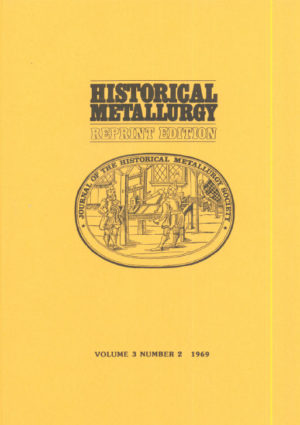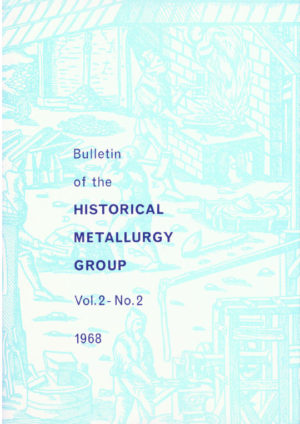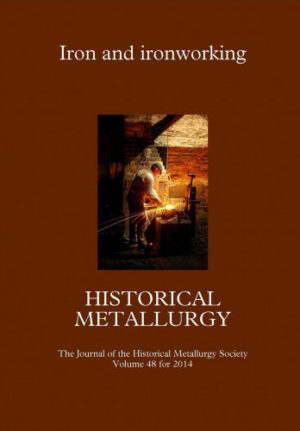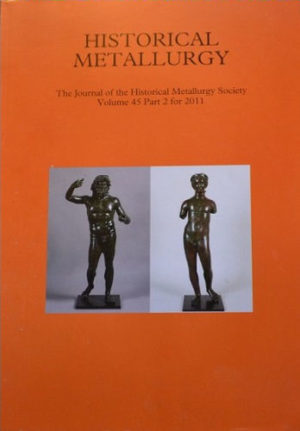Journal Contents
Ancient Chinese copper smelting, sixth century BC: recent excavations and simulation experiments
Edited and translated by D.B Wagner
Pages 1-16
Excavations at the ancient copper-mine site at Tonglushan in Daye County, Hubei, have in recent years produced a great wealth of new material concerning ancient Chinese mining and smelting techniques. The present article describes recent work on ten copper-smelting shaft furnaces found here.
Melting tin in the West of England: part 2
B. Earl
Pages 17-32
This is the second of two papers on the experimental smelting of tin which was carried out with HMS support. The first appeared in the last issue of the Journal, 1985, Vol. 19, No. 2, pp. 153-161.
Two forms of furnace were used for the investigation. For the first it was assumed that some form of bowl furnace was used before the introduction of the ‘Alman’ design. It was taken that the fuel was charcoal, the feed some form of cassiterite concentrate, that no flux — other than that introduced from the charcoal ash — was employed, the furnace some form of refractory lined pit and, largely as a convenience, a forced air draft was used; it was well known that an air furnace could readily reach conditions where cassiterite would be reduced to metal, but to work well such a furnace had to be rather large. The second was the blast type.
Bell moulds from Kirkstall Abbey, West Yorkshire
H B Duncan and S Wrathmell
Pages 33-35
In 1954 the Thoresby Society carried out its fifth season of excavations at Kirkstall Abbey, near Leeds, West Yorkshire (SE 259 361). One of the three areas investigated in that year was the monastic kitchen, a rectangular building measuring about 8m by 9.5m, It contained a square, open cooking hearth of several structural phases, positioned towards the centre of the floor. During the later Middle Ages an elongated pit had been cut down against the west side of the hearth.’ In the bottom of the pit was an annular object of fired clay and ‘charcoal’, set on a group of hearthstones. This was identified as the upturned rim of a crucible. Fragments of metallic residues lying around it were analysed and found to be alloys of copper.
In view of more recent discoveries, Leeds City Museum kindly allowed the Abbey kitchen ‘crucible’ to be re-examined. The exercise was made difficult by the fact that, in the 1960s, the rim had been incorporated in full and unrestrained reconstruction of a crucible. Nevertheless, it has been possible to reassign the fragments to the rim of a bell-mould — in situ when excavated — and to establish some details of manufacture and use which amplify discussions in the Cheddar report.
XRF analyses of some Anglo-Saxon copper alloy finds from Watchfield, Oxfordshire
C Mortimer, A M Pollard and C Scull
Pages 36-42
Forty X-Ray Fluorescence analyses of Anglo-Saxon period copper alloy objects are presented, from a recent rescue excavation of a cemetery at Watchfield, Oxfordshire. These results are compared with those from Sutton Hoo, together with the few other data available in the literature. It is suggested that these and other Anglo-Saxon copper alloy objects could have been made entirely from scrap brass and pewter, although this cannot be proved from such analyses. In addition, a white metal alloy is identified, containing copper and tin, with a little zinc but no silver, of a type previously found in Continental Merovingian contexts. This together with the more common quaternary metal apparently represents a deliberate attempt to imitate both silver and gold using appropriate copper alloys.
Melting points and viscosities of ancient slags: A discussion
Peter Kresten
Pages 43-45
Melting point estimates derived from various phase diagrams have to be regarded as yielding hazardous results. The viscosity coefficient K of Bachmann (1980) does not describe actual viscosities within the working range of furnaces and seems to violate basic concepts of phase diagrams. There is no convenient short-cut to either of the parameters — actual measurements are required.
For the archaeometallurgist, the melting points and viscosities of ancient slags are important parameters, which reflect advances in furnace technology. Both parameters can be measured by instrumental methods. However, methods of estimation of these parameters have been presented which, if accurate enough, could be talcen instead of actual measurements.
Nineteenth Century British Lead Pigs in Oman
Gerd Weisgerber and Ali A B al-Shanfarii
Pages 46-62
In archaeological contexts hammerscale and slag spheres (spheroidal
hammerscale) are indicative of iron smithing. Often they are not considered to hold any other information, but scale and spheres are the result of a number of different processes, and analyses can provide more detailed information on the type of work that was going on in a smithy. This paper provides a brief overview of the study of samples from 18 smithies in Denmark, Norway and Sweden dating from the Iron Age to the 18th century. A total of around 2000 hammerscale fragments, and 800 slag spheres, have so far been analysed.
![[Test] The Historical Metallurgy Society](https://test.historicalmetallurgy.org/wp-content/uploads/2020/02/Logo120.png)





There are no reviews yet.